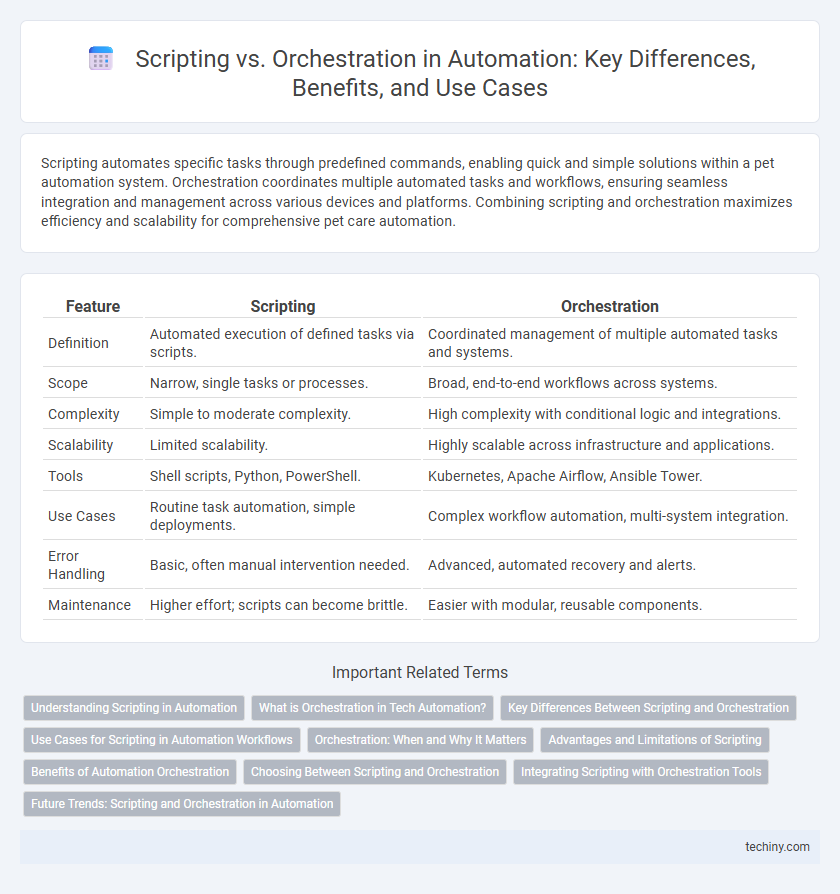Scripting automates specific tasks through predefined commands, enabling quick and simple solutions within a pet automation system. Orchestration coordinates multiple automated tasks and workflows, ensuring seamless integration and management across various devices and platforms. Combining scripting and orchestration maximizes efficiency and scalability for comprehensive pet care automation.
Table of Comparison
| Feature | Scripting | Orchestration |
|---|---|---|
| Definition | Automated execution of defined tasks via scripts. | Coordinated management of multiple automated tasks and systems. |
| Scope | Narrow, single tasks or processes. | Broad, end-to-end workflows across systems. |
| Complexity | Simple to moderate complexity. | High complexity with conditional logic and integrations. |
| Scalability | Limited scalability. | Highly scalable across infrastructure and applications. |
| Tools | Shell scripts, Python, PowerShell. | Kubernetes, Apache Airflow, Ansible Tower. |
| Use Cases | Routine task automation, simple deployments. | Complex workflow automation, multi-system integration. |
| Error Handling | Basic, often manual intervention needed. | Advanced, automated recovery and alerts. |
| Maintenance | Higher effort; scripts can become brittle. | Easier with modular, reusable components. |
Understanding Scripting in Automation
Scripting in automation involves writing code to execute specific, repetitive tasks, enabling precise control over individual processes. It typically uses languages like Python, Bash, or PowerShell to automate routine workflows and reduce manual effort. Unlike orchestration, scripting focuses on task-level automation rather than managing complex, multi-system workflows.
What is Orchestration in Tech Automation?
Orchestration in tech automation involves coordinating multiple automated tasks, workflows, and processes to work seamlessly together, ensuring efficient and scalable system operations. It integrates various tools, services, and scripts to automate complex IT environments, reducing manual intervention and errors. Key platforms like Kubernetes and Ansible enable orchestration by managing dependencies, resource allocation, and execution order across cloud and on-premises infrastructure.
Key Differences Between Scripting and Orchestration
Scripting involves writing code to automate individual, repetitive tasks, typically executed sequentially on a single system or environment. Orchestration integrates multiple automated scripts and processes across diverse systems, managing dependencies, workflows, and resource allocation to achieve complex, coordinated operations. Key differences include orchestration's ability to handle end-to-end workflows and scale automation across multiple platforms, whereas scripting focuses on task-level automation within a limited scope.
Use Cases for Scripting in Automation Workflows
Scripting in automation workflows excels at automating repetitive, straightforward tasks such as file management, data extraction, and system configuration changes. It enables quick execution of customized commands and simple integrations across local systems without the complexity of managing multi-step processes. Scripting is ideal for use cases where flexibility and immediate task automation are prioritized over comprehensive coordination of multiple services.
Orchestration: When and Why It Matters
Orchestration matters when managing complex IT workflows requiring coordination among multiple automated tasks across diverse systems and environments. It ensures seamless integration, efficient resource allocation, and end-to-end process visibility, critical for scalability and error reduction. Enterprises adopting cloud-native architectures and microservices rely on orchestration tools like Kubernetes and Apache Airflow to automate deployment, monitoring, and lifecycle management.
Advantages and Limitations of Scripting
Scripting offers simplicity and speed for automating repetitive tasks by using custom code or command sequences, enabling precise control over individual processes. It is highly flexible and adaptable to specific environments but becomes difficult to manage and scale as complexity and task interdependencies increase. Limited error handling and lack of centralized management pose challenges for maintaining consistent automation workflows in large-scale IT operations.
Benefits of Automation Orchestration
Automation orchestration enhances operational efficiency by integrating multiple automated tasks into cohesive workflows, reducing manual intervention and minimizing errors. It provides centralized control and real-time monitoring across diverse systems, improving scalability and adaptability in complex IT environments. Organizations achieve faster deployment cycles, optimized resource utilization, and increased compliance through standardized automated processes.
Choosing Between Scripting and Orchestration
Choosing between scripting and orchestration hinges on the complexity and scale of automation tasks; scripting excels in automating simple, repetitive tasks with customized commands, while orchestration manages and coordinates multiple automated processes across systems. Scripting offers granular control through languages like Python or Bash, ideal for task-specific automation, whereas orchestration leverages platforms such as Kubernetes or Ansible to streamline workflows and maintain consistency in large-scale environments. Understanding the scope of automation goals and infrastructure integration is crucial for selecting the most effective approach to enhance operational efficiency.
Integrating Scripting with Orchestration Tools
Integrating scripting with orchestration tools enhances automation by combining customizable task automation with centralized workflow management, enabling seamless coordination of complex processes across diverse systems. Scripting provides granular control over individual tasks, while orchestration tools like Kubernetes or Apache Airflow manage dependencies, scheduling, and execution order, ensuring efficient resource utilization and error handling. This integration optimizes operational efficiency, reduces manual intervention, and accelerates deployment cycles in IT environments.
Future Trends: Scripting and Orchestration in Automation
Scripting remains a critical component for task-level automation, enabling quick customization and precise control over specific processes. Orchestration platforms are evolving to integrate AI-driven decision-making, enhancing coordination across complex workflows and diverse systems. Future automation strategies will increasingly combine scripting agility with orchestration scalability to optimize efficiency and adaptability in dynamic IT environments.
Scripting vs Orchestration Infographic

 techiny.com
techiny.com